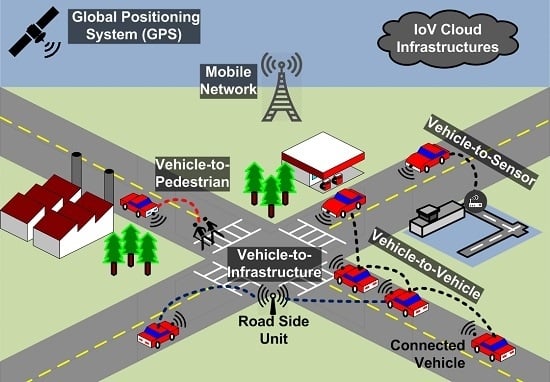Security in Intelligent Transport Systems for Smart Cities: From Theory to Practice
Abstract
:1. Introduction
2. Related Works
2.1. Key Enabling Standards
2.2. Security Threats and Countermeasures
2.3. Evaluation of ITS Standard Compliant Security Architectures
2.4. Performance Metrics
3. ITS Security Architecture
3.1. Security Architecture
3.2. Security Headers
| Listing 1: ETSI ITS SecuredMessage Structure. | |
Struct {
uint8 protocol_version;
HeaderField header_fields<var>;
Payload payload_field;
TrailerField trailer_fields<var>;
} SecuredMessage; | |
3.3. Certificate Format
| Listing 2: ETSI ITS Certificate Structure. |
Struct {
uint8 version;
SignerInfo signer_info;
SubjectInfo subject_info;
SubjectAttribute subject_attributes<var>;
ValidityRestriction validity_restrictions<var>;
Signature signature;
} Certificate; |
3.4. Security Profiles
3.4.1. Elliptic Curve Digital Signature Algorithm (ECDSA)
- A message digest is computed using a hash function (e.g., SHA-256) over the message plain text to be secured. For example, in case of a CAM message to be signed, the digest is computed over the CAM’s protocol_version, header_fields, payload_field and the length of the trailer_fields and the type of the signature trailer field;
- Then, the obtained message digest is encrypted using a public key algorithm (e.g., ecdsa_nistp256_with_sha256) and the private key of the ITS sender. The resulting encrypted message digest is known as the message’s signature;
- Finally, a digitally signed message is built based on the original message plain text, the computed signature and the ITS sender’s certificate. This secured message can thus be transmitted over the wireless channel.
- The message plain text is extracted from the SecuredMessage, and a message digest is computed using a hash function (e.g., SHA-256).
- Then, the message’s signature is extracted from the SecuredMessage, and is decrypted using a public key algorithm (e.g., ecdsa_nistp256_with_sha256) and the sender’s public key (i.e., contained in the received sender’s certificate). The obtained decrypted signature represents the message digest as originally computed by the sender.
- Finally, the receiver compares the decrypted message digest (step 2) with the newly computed message digest (step 1). If both digests are equal, the signature is thus considered as valid, as well as the integrity and authenticity of the received data.
3.4.2. Elliptic Curve Integrated Encryption Scheme (ECIES) with Advanced Encryption Standard (AES)
- First, a pair of ephemeral key is generated, where the ephemeral private key is u and its public key is , where G is the point of the considered elliptic curve, and “·” denotes a scalar multiplication;
- Second, a key agreement function (e.g., Diffie-Hellman with cofactor multiplication) is used to generated a shared secret using the sender’s ephemeral private key (u) and the receiver’s public key (V);
- Third, the obtained shared secret along with optional parameters (i.e., null according to the ETSI TC ITS specifications) are fed into a key derivation function (KDF), based on KDF2 with SHA-256, whose output is the concatenation of the message authentication code (MAC) key () and the encryption key ();
- Fourth, an AES secret key (m) is generated by the transmitter and is encrypted using a stream cipher and the encryption key . The obtained encrypted AES key is denoted as c;
- Fifth, the encrypted AES key c, the MAC key and optional parameters (i.e., null according to the ETSI TC ITS specifications) are fed into a MAC function with SHA-256 to generate a of 128 bits;
- Sixth, the ITS message (M) is encrypted using the AES algorithm (i.e., aes_128_ccm) and the AES secret key which was generated in step 4;
- Finally, the sender’s ephemeral public key (U), the , the encrypted AES key (c) and the encrypted ITS message (C) are encapsulated into a secured message, along with other headers and fields, and which is transmitted through the wireless channel to the remote ITS receiver.
- First, the ITS sender’s ephemeral public key (U), the , the encrypted AES key (c) and the encrypted ITS message (C) are extracted from the received secured message;
- Second, the ITS sender’s ephemeral public key U and ITS receiver private key V are fed into a key agreement function to generate the shared secret [36];
- Third, the shared secret along with optional parameters (i.e., null according to the ETSI TC ITS specifications) are fed in a key derivation function (KDF), whose output is the concatenation of the message authentication code (MAC) key () and the encryption key ();
- Fourth, the encrypted message c, the MAC key and optional parameters (i.e., null according to the ETSI TC ITS specifications) are fed into a MAC function to generate a new that is compared with the received . If the values are different, the received secured message should be discarded by the receiver;
- Fifth, the received encrypted AES key c is decrypted using the encryption key (), and the original AES key m is obtained;
- Finally, the encrypted ITS message C is decrypted using the AES key m, and the original ITS message M is obtained and can be further processed by the ITS communication stack and applications.
4. Test-Bed and Experimental Benchmark
4.1. Test-Bed Setup
4.2. Experimental Results
5. ITS Security Case Study in Smart cities
5.1. Simulations Setup
5.2. Simulations Results
5.2.1. Safety Application
QoS Metrics
Security Metrics
Safety Awareness Metrics
5.2.2. Query Application
5.3. Lessons Learned and Open Challenges
6. Conclusions
Acknowledgments
Author Contributions
Conflicts of Interest
References
- Brahim, M.; Ben Hamida, E.; Filali, F.; Noura, H. Performance Impact of Security on Cooperative Awareness in Dense Urban Vehicular Networks. In Proceedings of the IEEE International Conference on Wireless and Mobile Computing, Networking and Communications, Abu Dhabi, UAE, 19–21 October 2015; pp. 1–7.
- Javed, M.A.; Ngo, D.T.; Khan, J.Y. Distributed spatial reuse distance control for basic safety messages in SDMA-based VANETs. Veh. Commun. 2015, 2, 27–35. [Google Scholar] [CrossRef]
- Javed, M.A.; Khan, J.Y. A geocasting technique in an IEEE802. 11p based vehicular ad hoc network for road traffic management. In Proceedings of the Australasian Telecommunication Networks and Applications Conference, Melbourne, Australia, 9–11 November 2011; pp. 1–6.
- Ben Othmane, L.; Al-Fuqaha, A.; Ben Hamida, E.; van den Brand, M. Towards extended safety in connected vehicles. In Proceedings of the IEEE Intelligent Transportation Systems, The Hague, The Netherlands, 2013; pp. 652–657.
- Javed, M.A.; Khan, J.Y. Performance analysis of an adaptive rate-range control algorithm for VANET safety applications. In Proceedings of the International Conference on Computing, Networking and Communications, Honolulu, HI, USA, 3–6 February 2014; pp. 418–423.
- Javed, M.A.; Khan, J.Y.; Ngo, D.T. Joint space-division multiple access and adaptive rate control for basic safety messages in VANETs. In Proceedings of the IEEE Wireless Communication and Networking Conference, Istanbul, Turkey, 6–9 April 2014; pp. 2688–2693.
- Javed, M.A.; Khan, J.Y. A Cooperative Safety Zone Approach to Enhance the Performance of VANET Applications. In Proceedings of the IEEE Vehicular Technology Conference, Dresden, Germany, 2–5 June 2013; pp. 1–5.
- Javed, M.A.; Khan, J.Y.; Ngo, D.T. Multimedia Transmission for Emergency Services in VANETs. In Proceedings of the IEEE Vehicular Technology Conference, Vancouver, BC, Canada, 14–17 September 2014; pp. 1–5.
- Javed, M.A.; Khan, J.Y. Performance analysis of a time headway based rate control algorithm for VANET safety applications. In Proceedings of the International Conference on Signal Processing and Communication Systems, Carrara, Australia, 16–18 December 2013; pp. 1–6.
- Javed, M.A.; Khan, J.Y.; Ngo, D.T. A Tone-Based Time-Slotted Protocol for Multi-Hop Emergency Message Dissemination in VANETs. In Proceedings of the IEEE Vehicular Technology Conference, Seoul, Korea, 18–21 May 2014; pp. 1–5.
- Qu, F.; Wu, Z.; Wang, F.; Cho, W. A Security and Privacy Review of VANETs. Proc. IEEE Trans. Intell. Transp. Syst. 2015, 16, 2985–2996. [Google Scholar] [CrossRef]
- Ben Hamida, E.; Noura, H.; Znaidi, W. Security of Cooperative Intelligent Transport Systems: Standards, Threats Analysis and Cryptographic Countermeasures. Electronics 2015, 4, 380–423. [Google Scholar] [CrossRef]
- Ben Hamida, E.; Znaidi, W.; Menouar, H. Implementation and Evaluation of the ETSI Security Architecture for Cooperative Intelligent Transport Systems. In Proceedings of the IEEE Vehicular Technology Conference (VTC-Fall), Boston, MA, USA, 6–9 September 2015; pp. 1–5.
- The Institute of Electrical and Electronics Engineers. IEEE Std 1609.2-2013, IEEE Standard for Wireless Access in Vehicular Environments (WAVE)—Security Services for Applications and Management Messages; Technical Report; IEEE: Hoboken, NJ, USA, 2013. [Google Scholar]
- The European Telecommunications Standards Institute. ETSI TS 103 097 v1.2.1 (2015-06)—Intelligent Transport Systems (ITS)—Security; Security Header and Certificate Formats; Technical Report; European Telecommunications Standards Institute: Valbonne, France, 2015. [Google Scholar]
- Javed, M.A.; Ngo, D.T.; Khan, J.Y. A multi-hop broadcast protocol design for emergency warning notification in highway VANETs. EURASIP J. Wirel. Commun. Netw. 2014, 2014. [Google Scholar] [CrossRef]
- Javed, M.; Ben Hamida, E. Measuring Safety Awareness in Cooperative ITS Applications. In Proceedings of the IEEE Wireless Communication and Networking Conference, Doha, Qatar, 3–6 April 2016; pp. 1–7.
- SafeITS Project: ETSI ITS Security Performance Benchmark. Available online: https://www.safeits.org/bench (accessed on 17 April 2016).
- IEEE Guide for Wireless Access in Vehicular Environments (WAVE)—Architecture; IEEE Std 1609.0-2013; IEEE: Hoboken, NJ, USA, 2014; pp. 1–78.
- ETSI Intelligent Transport Systems. Available online: http://www.etsi.org/technologiesclusters/technologies/intelligent-transport (accessed on 4 February 2016).
- The European Telecommunications Standards Institute. ETSI TR 102 863-2 v1.1.1—Intelligent Transport Systems (ITS)—Vehicular Communications—Basic Set of Applications—Local Dynamic Map: Rationale for and Guidance on Standardization; Technical Report; European Telecommunications Standards Institute: Valbonne, France, 2011. [Google Scholar]
- Bernstein, D.J.; Lange, T. eBACS: ECRYPT Benchmarking of Cryptographic Systems. Available online: http://bench.cr.yp.to (accessed on 17 April 2016).
- Moghimifar, F.; Stebila, D. Predicting TLS Performance from Key Exchange Performance. In Proceedings of the Australasian Computer Science Week Multiconference, Canberra, Australia, 2–5 February 2016; pp. 44:1–44:4.
- Kimmo Järvinen, J.S. Cryptoprocessor for Elliptic Curve Digital Signature Algorithm (ECDSA); Technical Report; Helsinki University of Technology: Espoo, Finland, 2007. [Google Scholar]
- Glas, B.; Sander, O.; Stuckert, V.; Müller-Glaser, K.D.; Becker, J. Prime Field ECDSA Signature Processing for Reconfigurable Embedded Systems. Int. J. Reconfig. Comput. 2011, 2011, 1051–1064. [Google Scholar] [CrossRef]
- Crypto++ 5.6.0 Benchmarks. Available online: https://www.cryptopp.com/benchmarks.html (accessed on 17 April 2016).
- Aschenbruck, N.; Gerhards-Padilla, E.; Lambertz, M. Applicability of crypto-based security approaches in tactical wireless multi-hop networks. In Proceedings of the IEEE Conference on Local Computer Networks, Clearwater, FL, USA, 22–25 October 2012; pp. 102–110.
- Moalla, R.; Lonc, B.; Segarra, G.; Laguna, M.; Papadimitratos, P.; Petit, J.; Labiod, H. Experimentation with the PRESERVE VSS and the Score@F System. In Proceedings of the 5th Conference on Transport Research Arena (TRA), Paris, France, 14–17 April 2014.
- Nowdehi, N.; Olovsson, T. Experiences from implementing the ETSI ITS SecuredMessage service. In Proceedings of the 2014 IEEE Intelligent Vehicles Symposium Proceedings, Dearborn, MI, USA, 8–11 June 2014; pp. 1055–1060.
- Banani, S.; Gordon, S. Selecting basic safety messages to verify in VANETs using zone priority. In Proceedings of the Asia-Pacific Conference on Communications, Pattaya, Thailand, 1–3 October 2014; pp. 423–428.
- Schmidt, R.; Lasowski, R.; Leinmüller, T.; Linnhoff-Popien, C.; Schafer, G. An approach for selective beacon forwarding to improve cooperative awareness. In Proceedings of the IEEE Vehicular Networking Conference, Jersey City, NJ, USA, 13–15 December 2010; pp. 182–188.
- Feiri, M.; Petit, J.; Schmidt, R.; Kargl, F. The impact of security on cooperative awareness in VANET. In Proceedings of the IEEE Vehicular Networking Conference, Boston, MA, USA, 16–18 December 2013; pp. 127–134.
- The European Telecommunications Standards Institute. ETSI TS 102 941 v1.1.1 (2012-06)—Intelligent Transport Systems (ITS)—Security; Security Header and Certificate Formats; Technical Report; European Telecommunications Standards Institute: Valbonne, France, 2012. [Google Scholar]
- Turner, S.; Brown, D.; Yiu, K.; Housley, R.; Polk, T. Elliptic Curve Cryptography Subject Public Key Information; RFC 5480; Internet Engineering Task Force (IETF): Fremont, CA, USA, 2009. [Google Scholar]
- Whiting, D.; Housley, R.; Ferguson, N. Counter with CBC-MAC (CCM); RFC 3610; Internet Engineering Task Force (IETF): Fremont, CA, USA, 2003. [Google Scholar]
- Gayoso Martínez, V.; Hernández Encinas, L.; Queiruga Dios, A. Security and Practical Considerations When Implementing the Elliptic Curve Integrated Encryption Scheme. Cryptologia 2015, 39, 244–269. [Google Scholar] [CrossRef]
- The European Telecommunications Standards Institute. ETSI TS 102 723-8 v1.0.4 (2014-07)—Intelligent Transport Systems (ITS)—OSI Cross-Layer Topics; Part 11: Interface between Networking and tRansport Layer and Facilities Layer; Technical Report; European Telecommunications Standards Institute: Valbonne, France, 2014. [Google Scholar]
- Ben Hamida, E.; Javed, M. Channel-Aware ECDSA Signature Verification of Basic Safety Messages with K-Means Clustering in VANETs. In Proceedings of the IEEE International Conference on Advanced Information Networking and Applications, Crans-Montana, Switzerland, 23–25 March 2016; pp. 1–8.
- Sepulcre, M.; Gozalvez, J.; Altintas, O.; Kremo, H. Integration of congestion and awareness control in vehicular networks. Ad Hoc Netw. 2016, 37 Pt 1, 29–43. [Google Scholar] [CrossRef]
- Yang, Q.; Wang, H. Toward trustworthy vehicular social networks. IEEE Commun. Mag. 2015, 53, 42–47. [Google Scholar] [CrossRef]
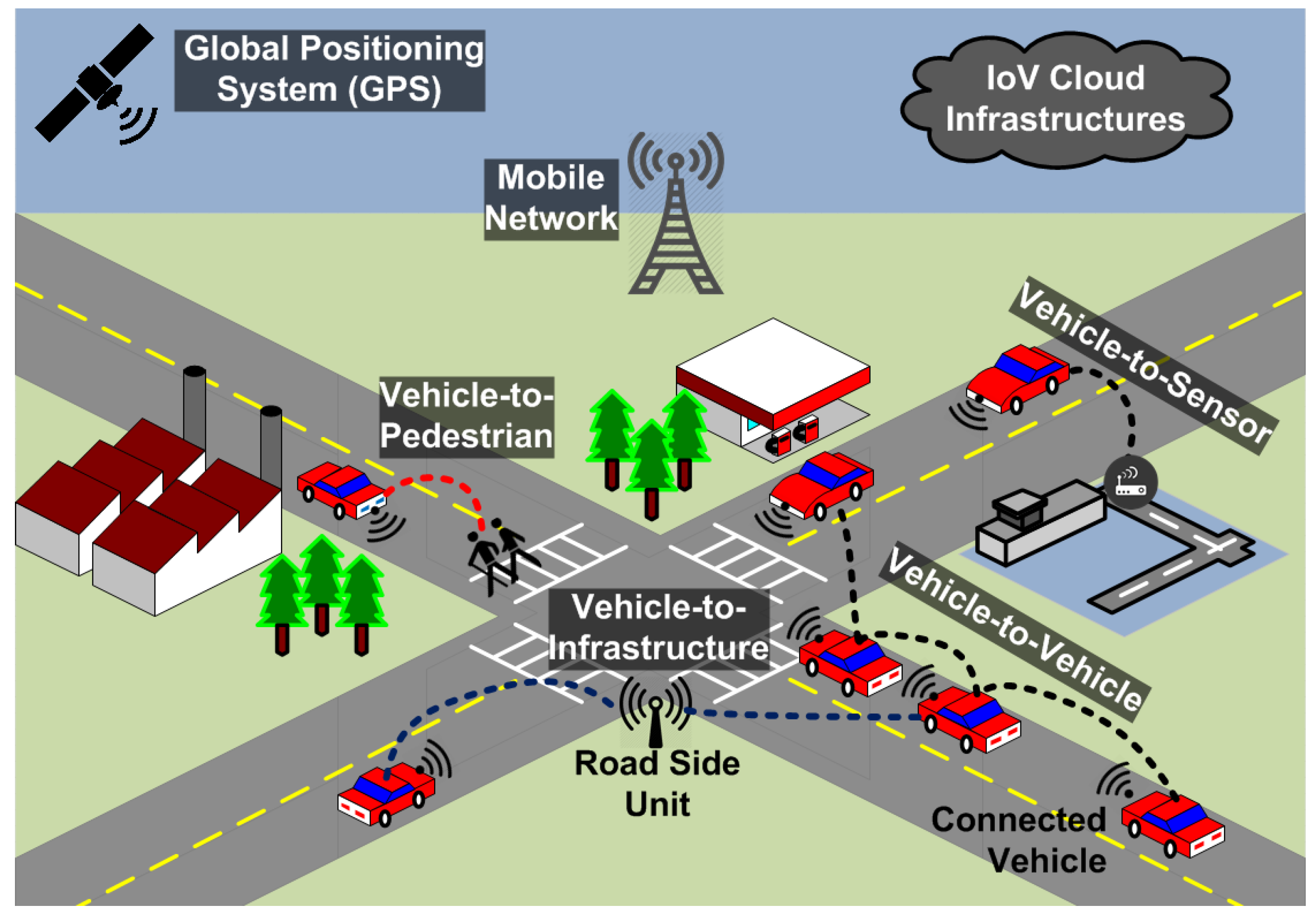
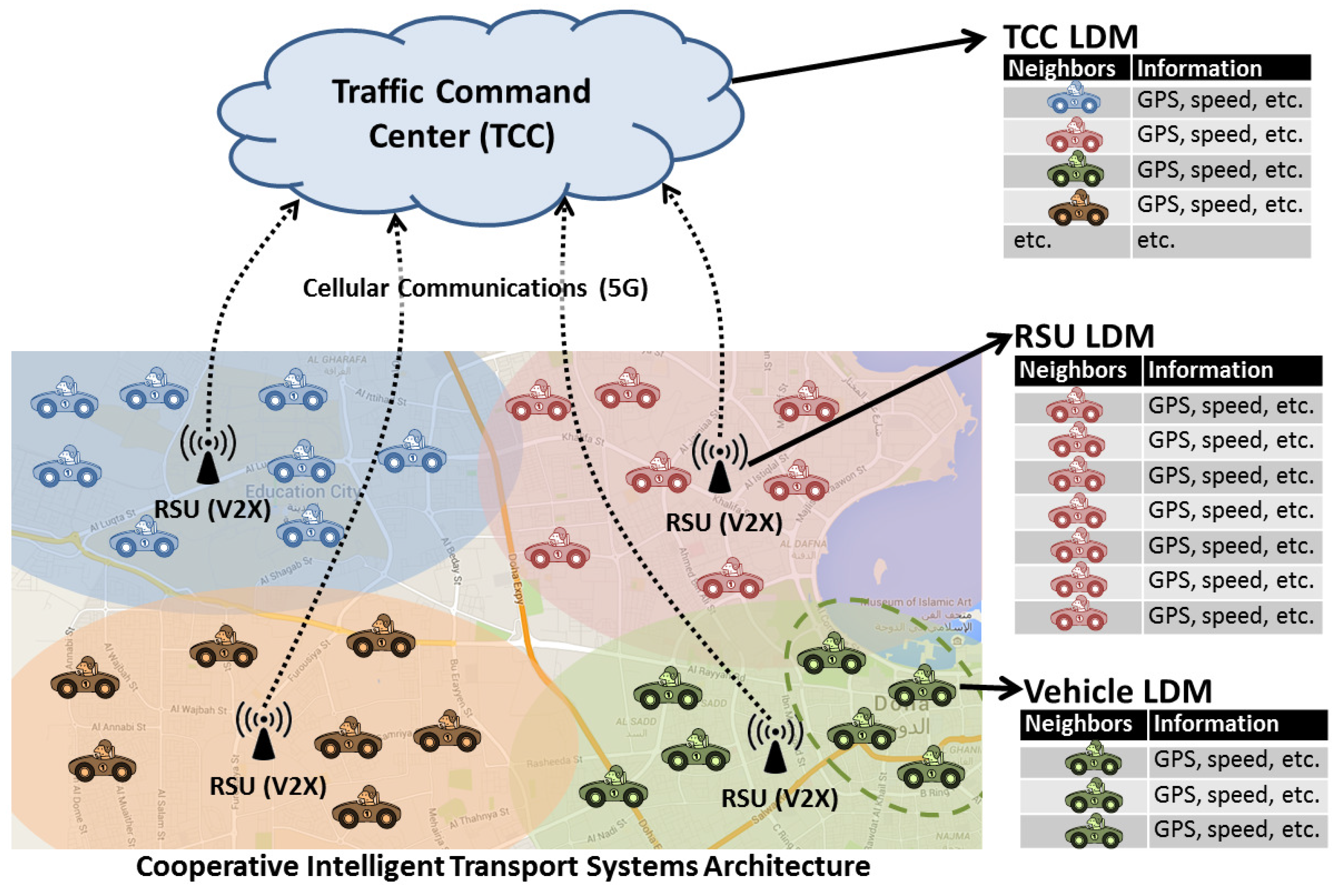
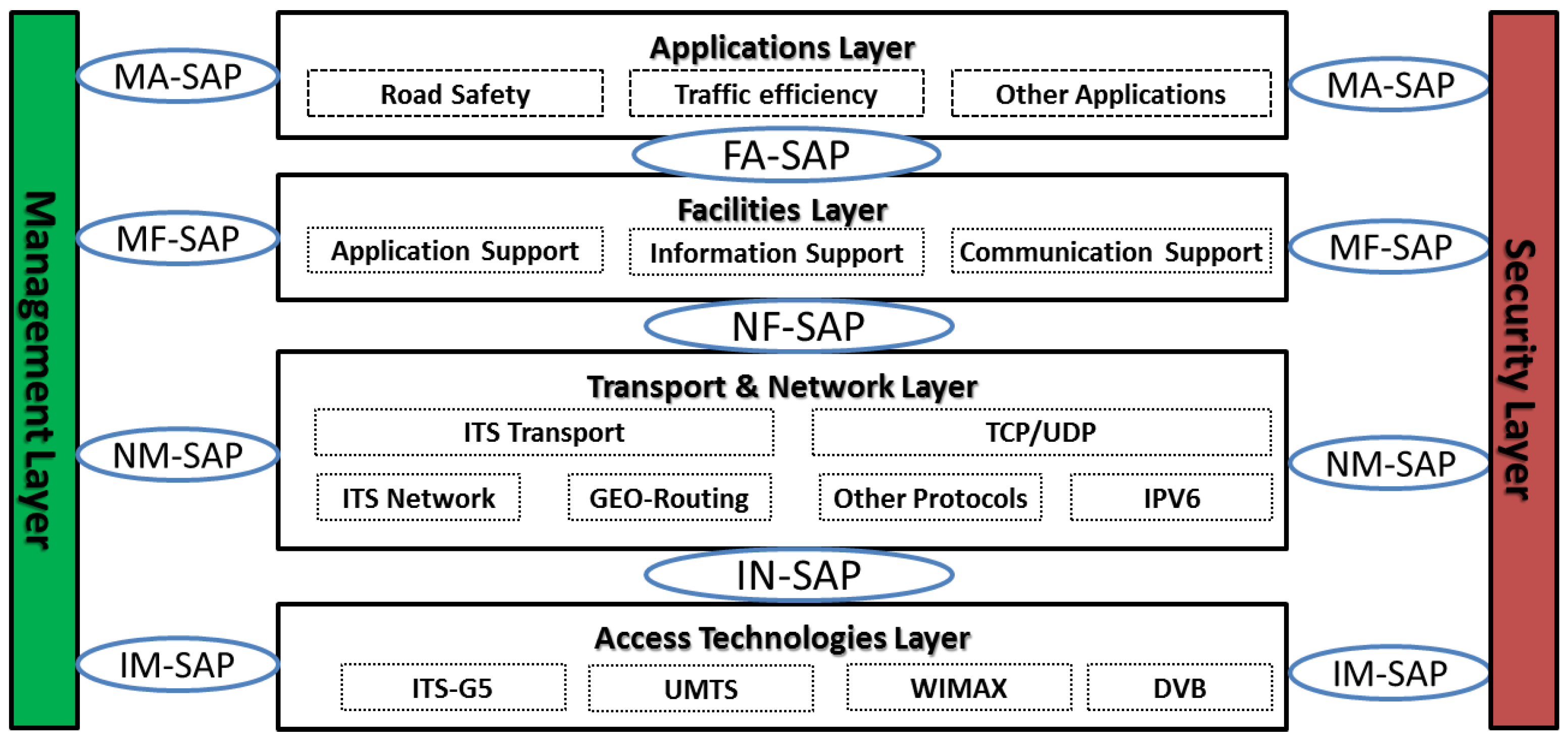

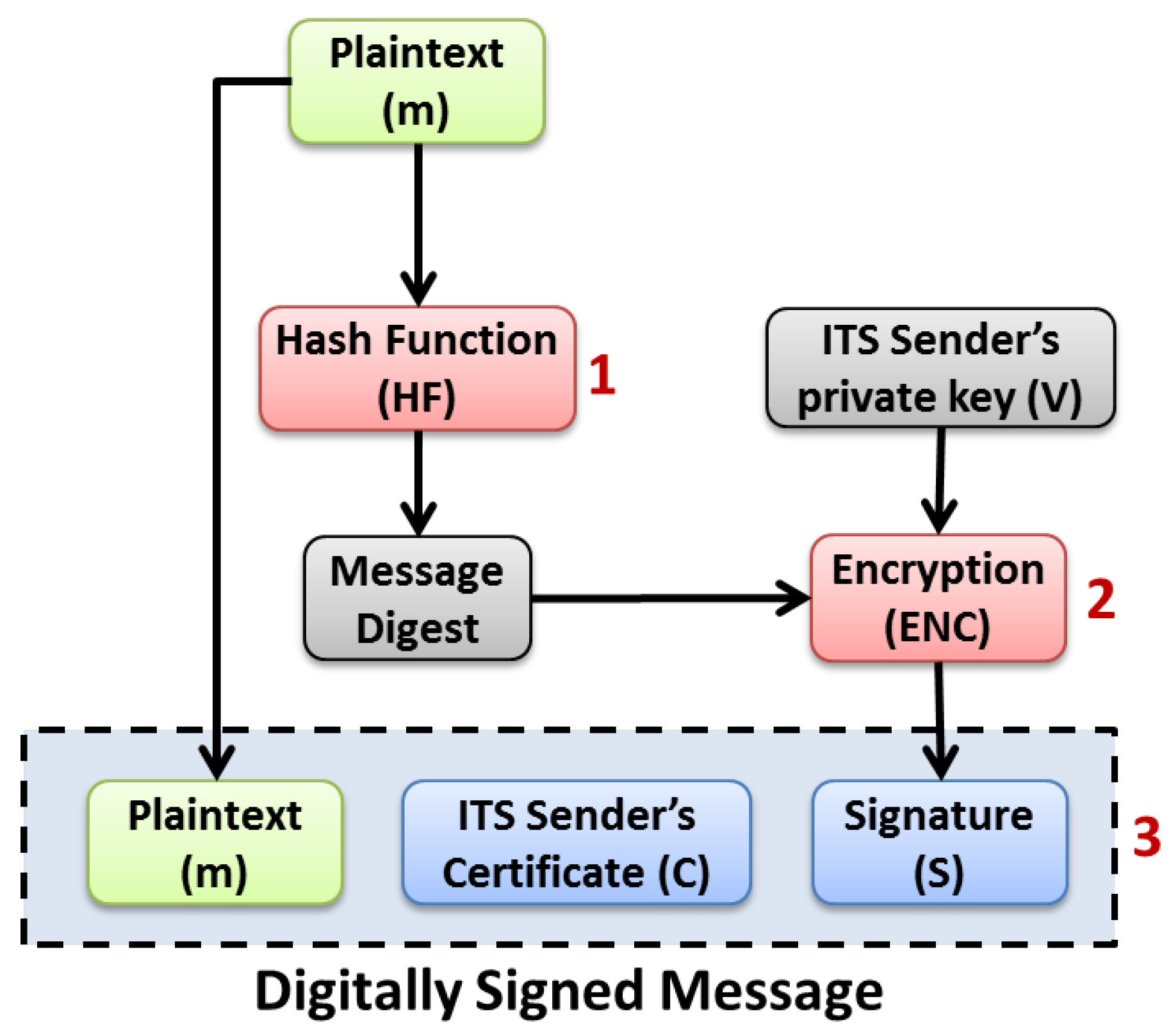


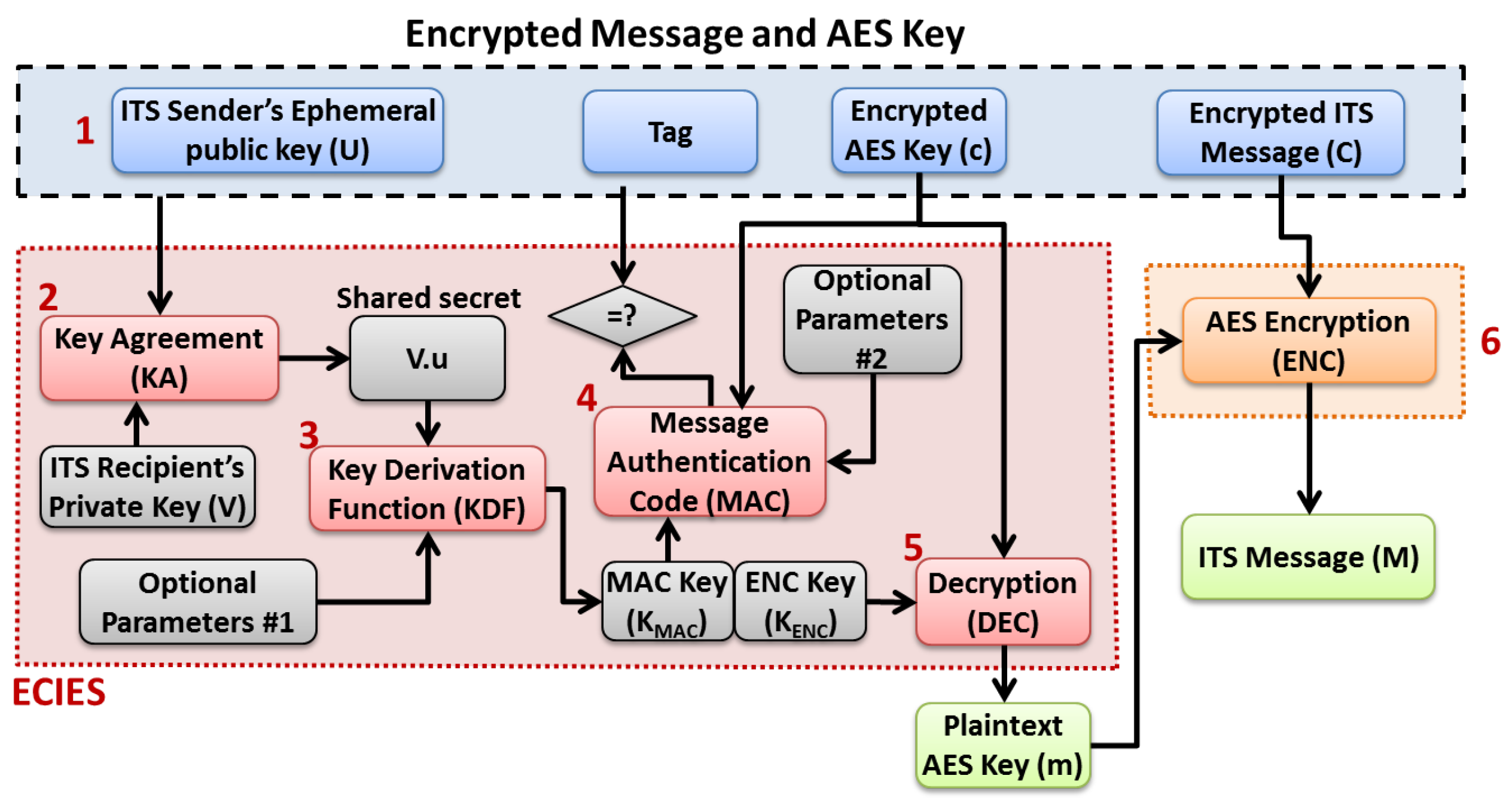
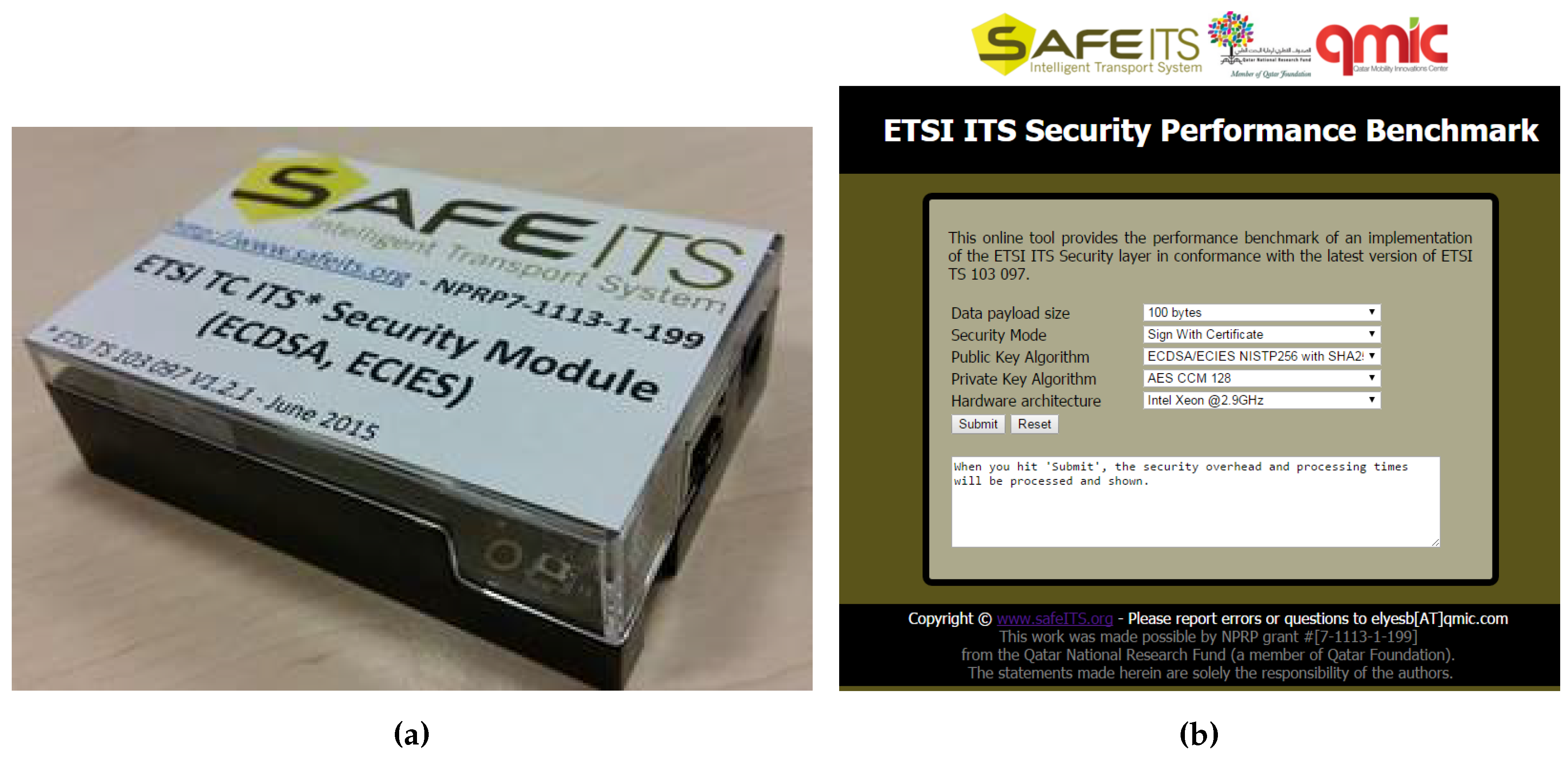


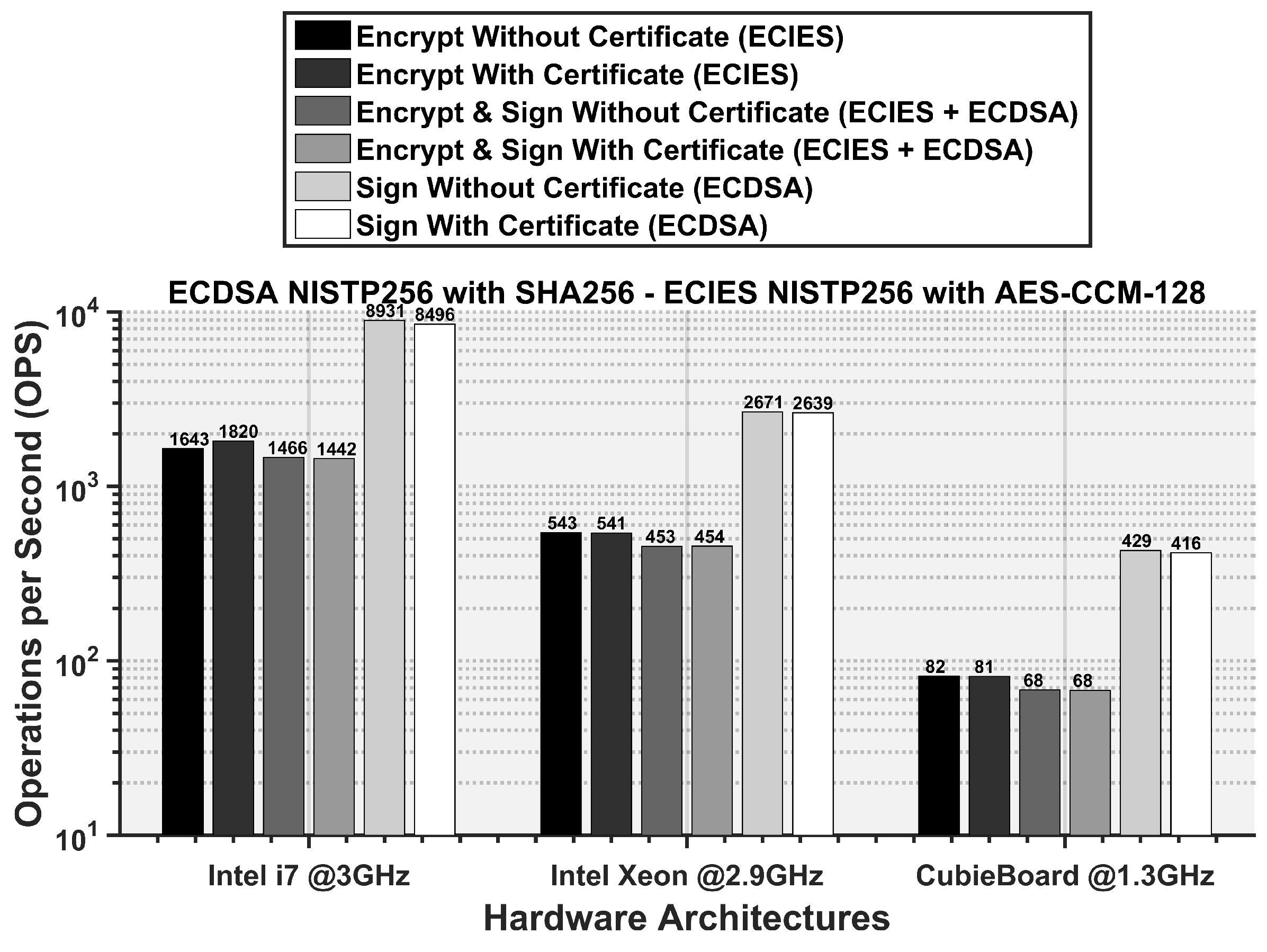
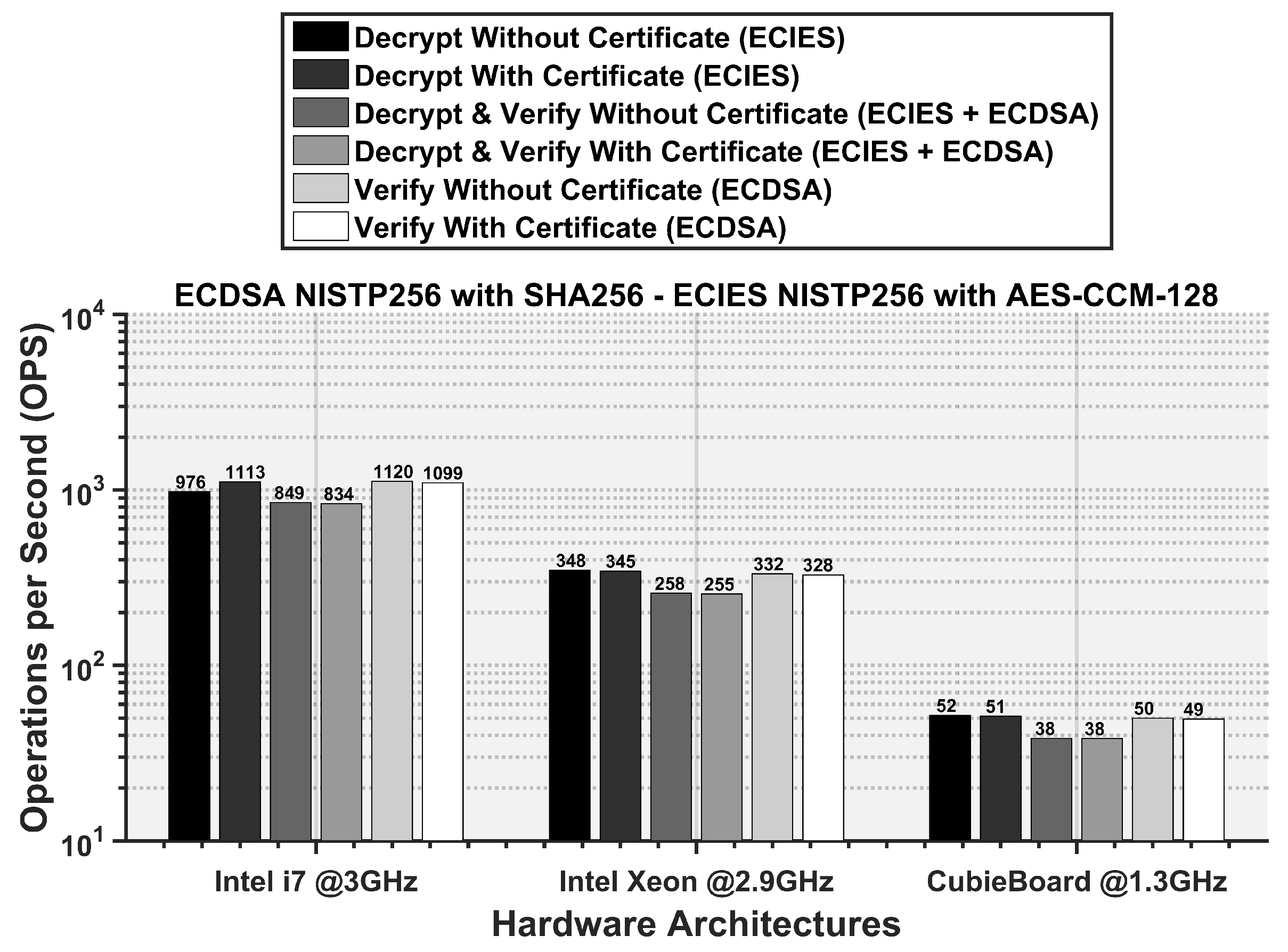
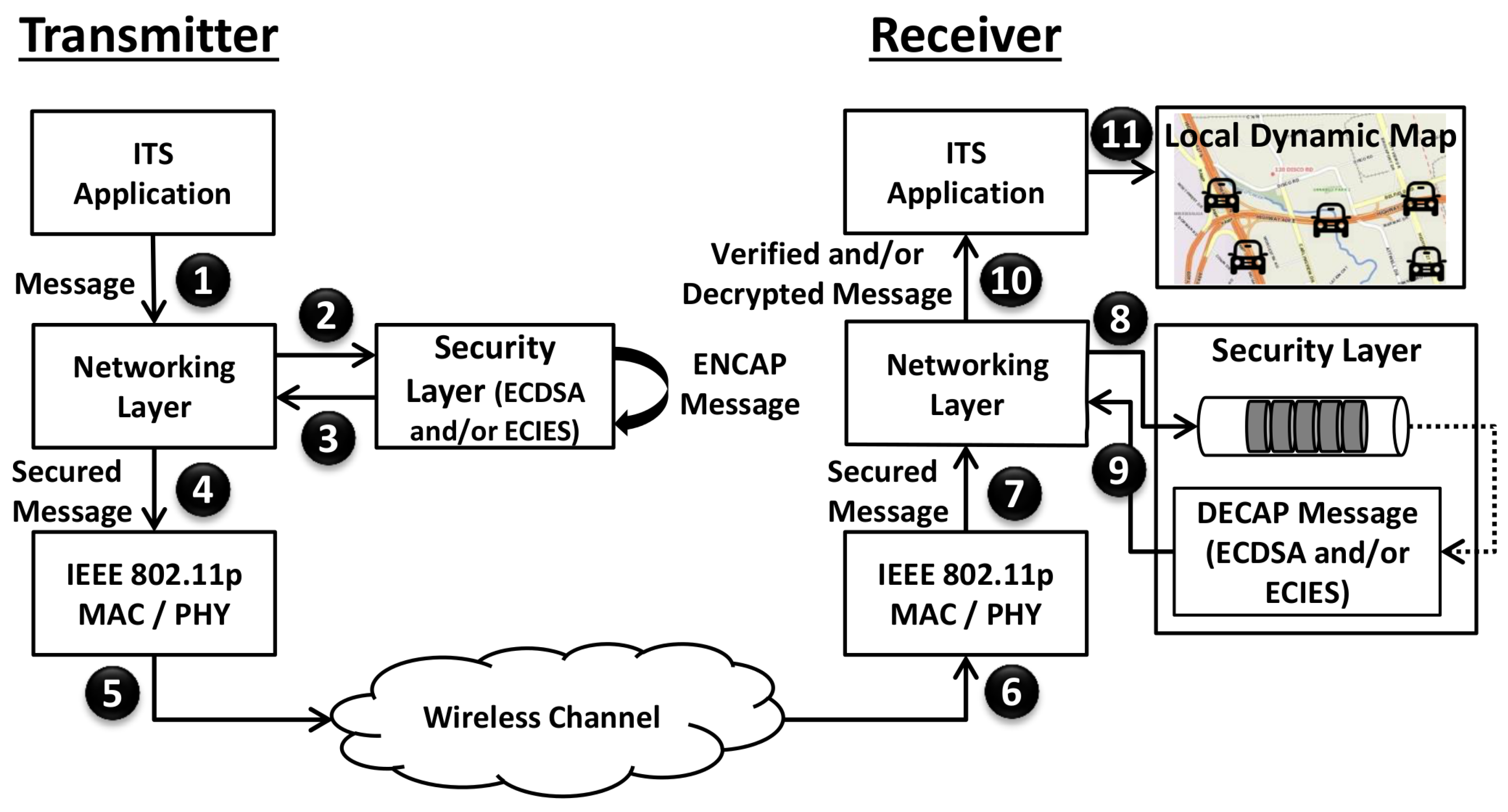
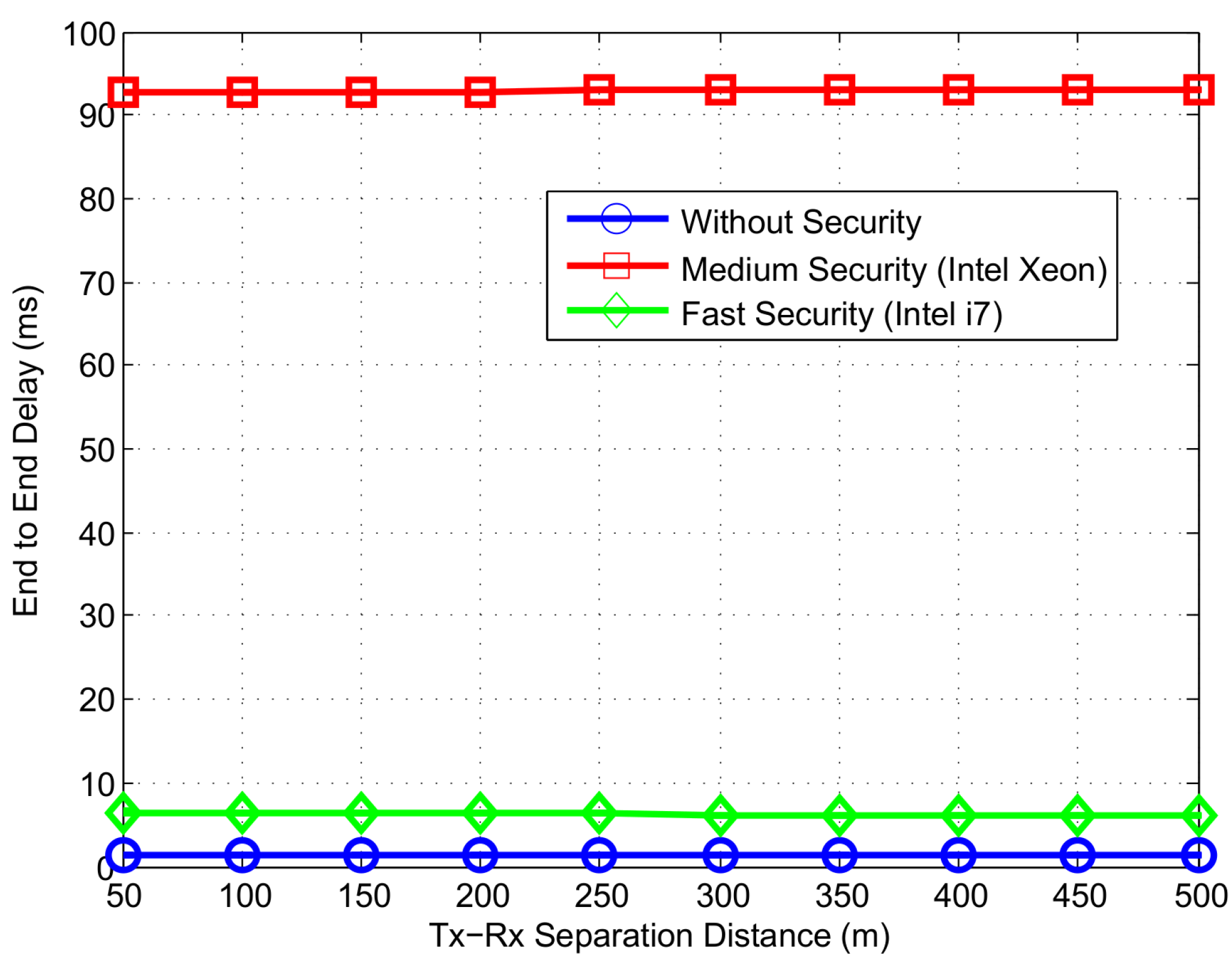
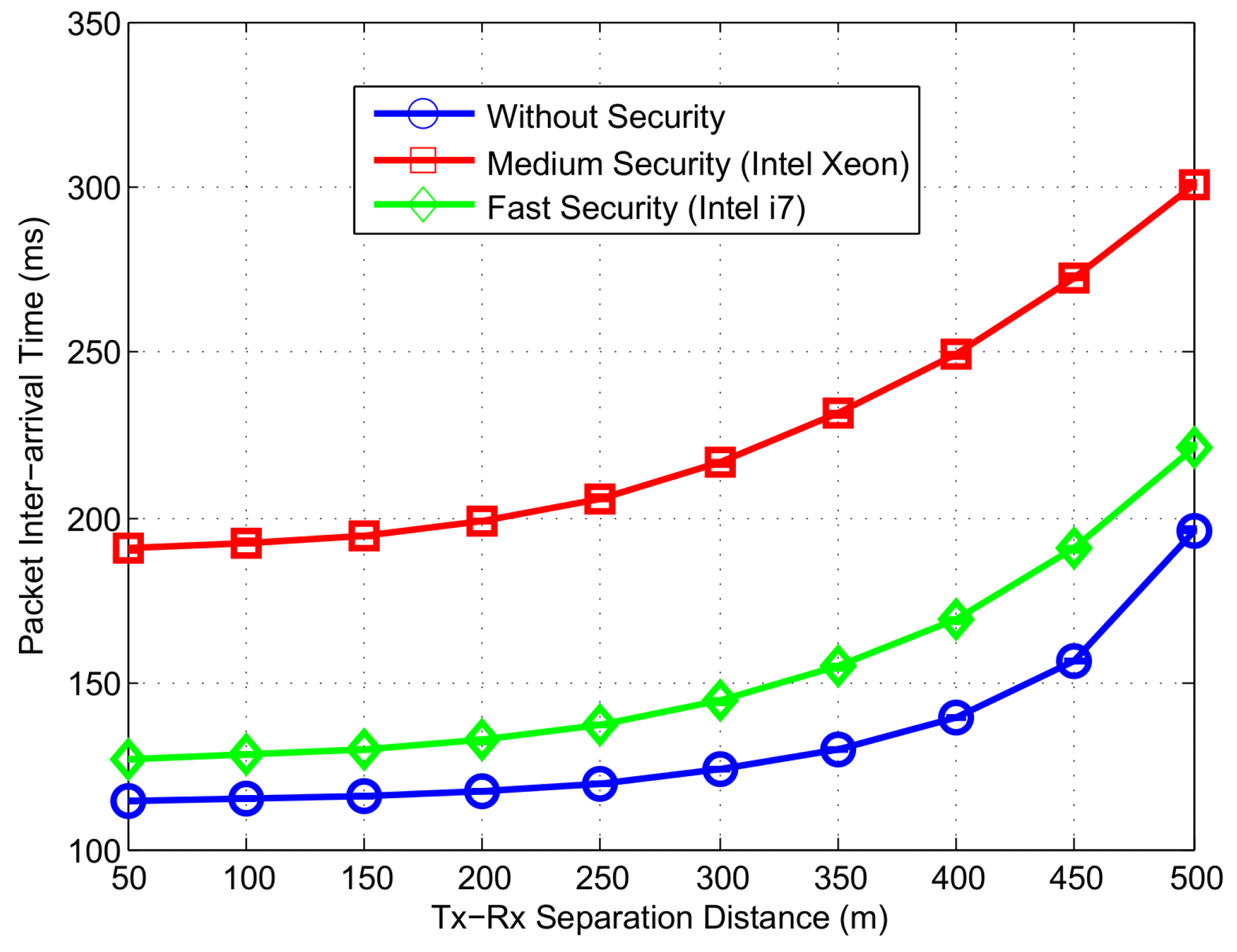
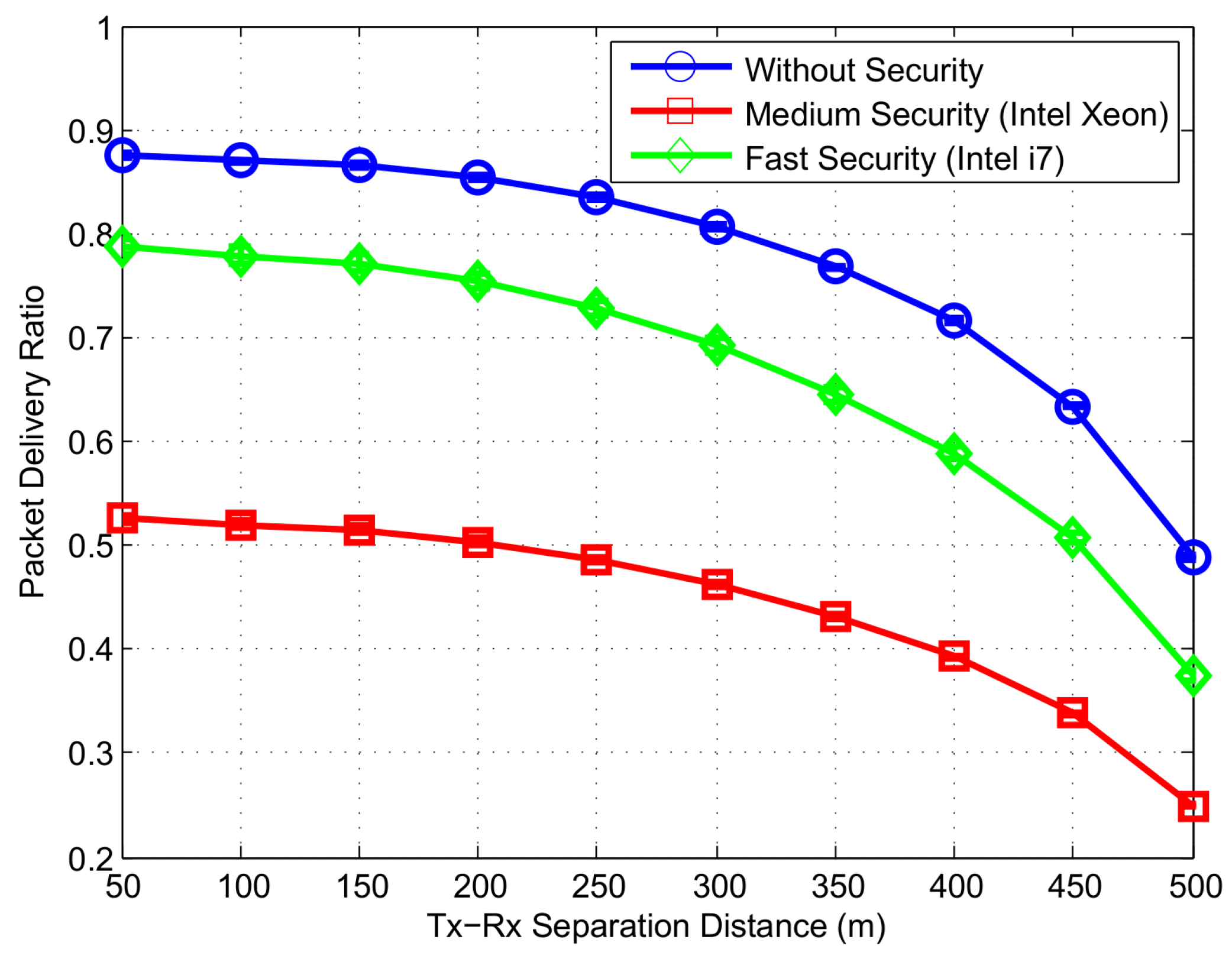
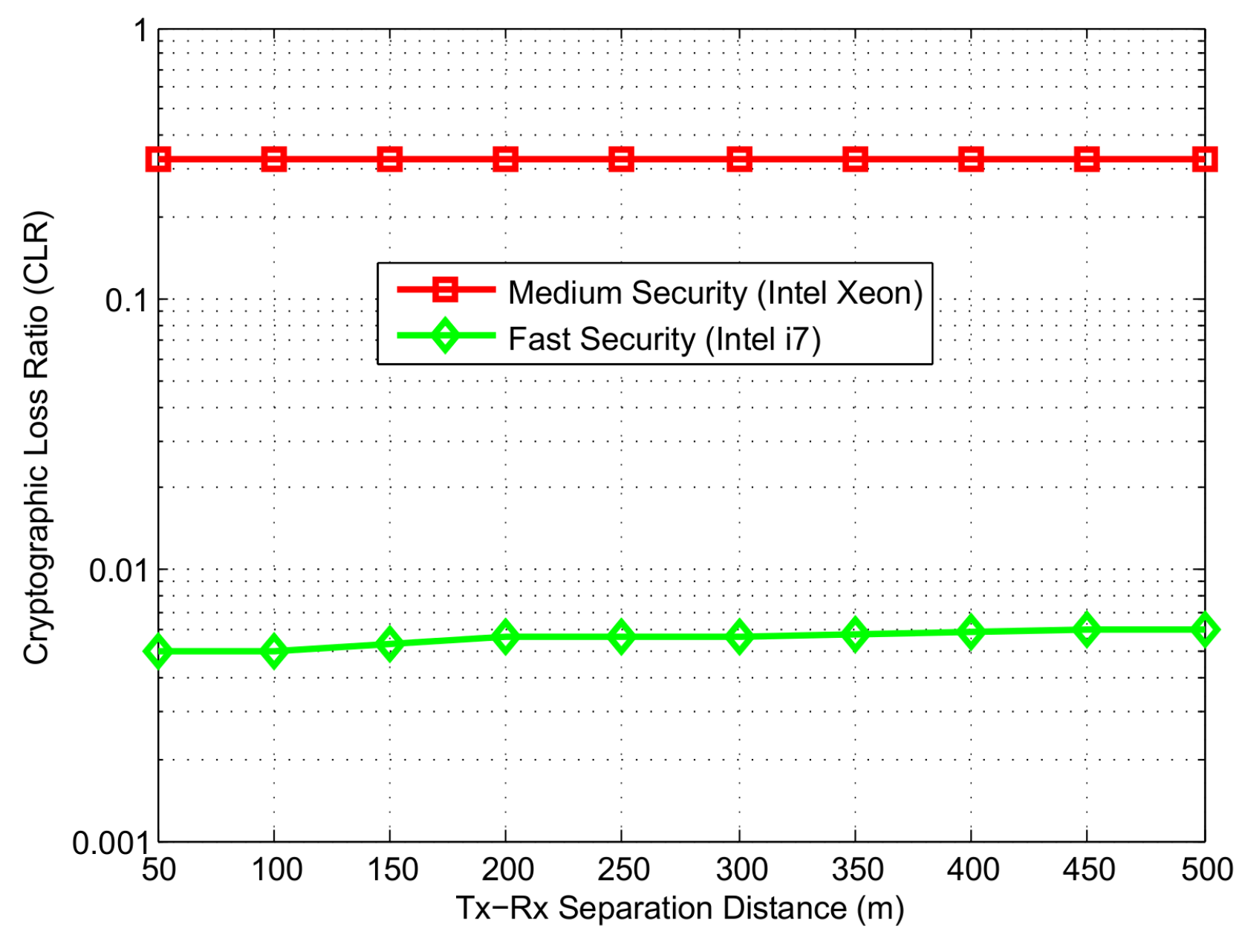
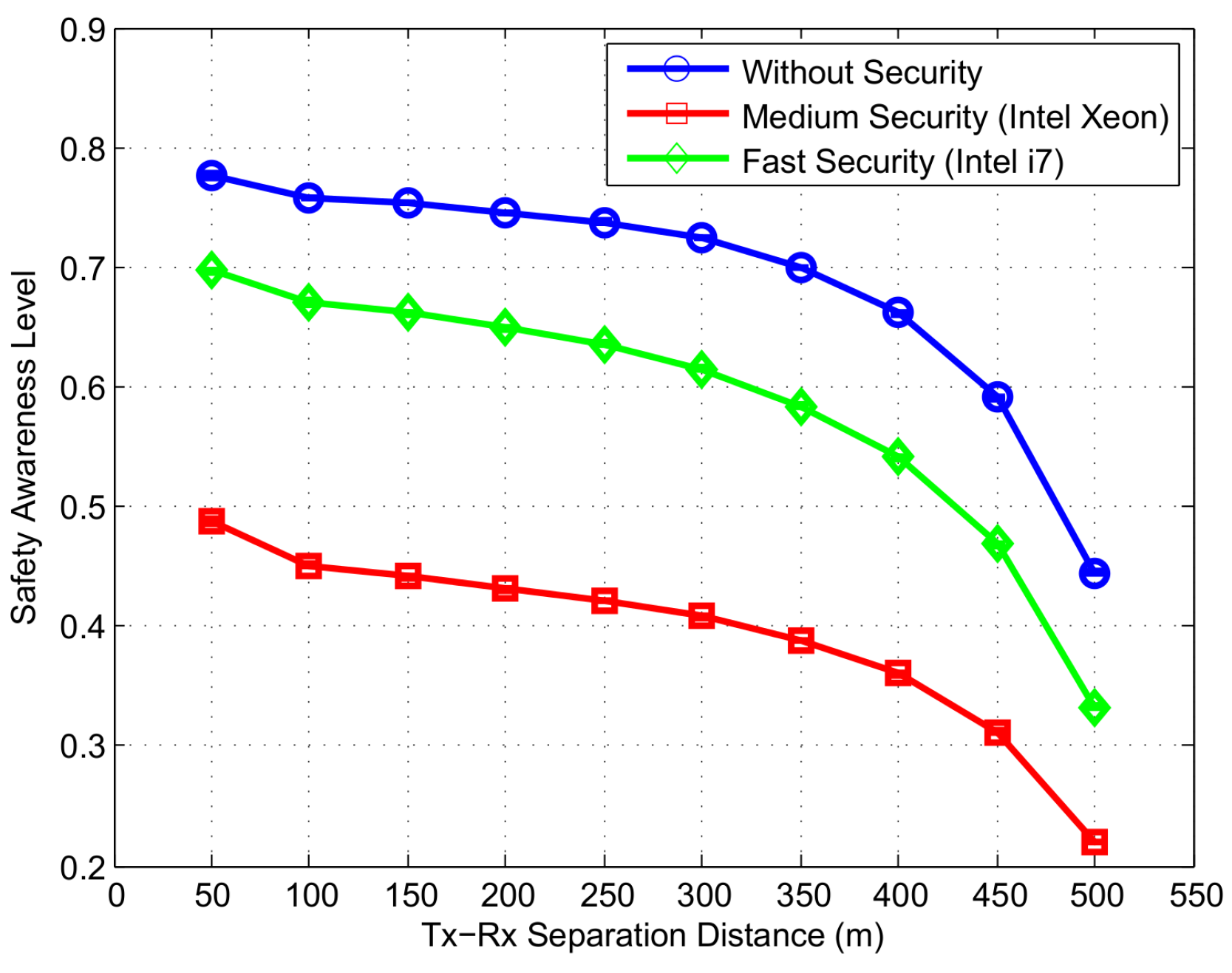
| Security Attack | Compromised Security Requirement | Countermeasure |
|---|---|---|
| Denial of Service (DoS) | Availability | Digital Signature |
| Jamming, Flooding | Availability | Digital Signature |
| Sybil | Availability, Authentication | Digital Signature |
| Malware, Spamming, Black hole, Grey hole, Sink hole, Warm hole | Availability, Authentication | Digital Signature |
| Eavesdropping | Confidentiality | Encryption |
| Data Interception | Confidentiality | Encryption |
| Falsified Entities | Authentication, Authorization | Digital Signature and Encryption |
| Cryptographic Replication | Authentication, Authorization | Digital Signature and Encryption |
| GNSS Spoofing | Authentication, Authorization | Digital Signature and Encryption |
| Timing | Authentication, Authorization | Digital Signature and Encryption |
| Masquerading | Data Integrity | Digital Signature with Certificate |
| Data Playback | Data Integrity | Digital Signature with Certificate |
| Data Alteration | Data Integrity | Digital Signature with Certificate |
| Security | ECDSA for Signing and Verifying ITS Safety Messages (e.g., CAMs) | ECIES with AES for Encrypting and Decrypting Sensitive ITS Communications |
|---|---|---|
| ETSI TC ITS | ECDSA NISTP-256 with SHA-256 | ECIES NISTP-256 with AES CCM 128/256 * |
| IEEE 1609.2 | ECDSA NISTP-224 with SHA-224 | ECIES NISTP-224 with AES CCM 128/256 * |
| NIST | ECDSA NISTP-192 with SHA-256 | ECIES NISTP-192 with AES CCM 128/256 * |
| ECDSA NISTP-224 with SHA-256 | ECIES NISTP-224 with AES CCM 128/256 * | |
| ECDSA NISTP-384 with SHA-384 | ECIES NISTP-384 with AES CCM 128/256 * |
| Hardware Architecture (CPU) | Description |
|---|---|
| Intel i7 (Fast Speed) | Intel(R) Core(TM) i7-4610 M CPU @ 3.00 GHz - 64 bits OS |
| Intel Xeon (Medium Speed) | Intel(R) Xeon(R) E5-2667 CPU @ 2.90 GHz - 64 bits OS |
| CubieBoard (Slow Speed) | ARM(R) Cortex-A8 AM335x CPU @ 1 GHz - 32 bits OS |
| Security Level | NISTP192-SHA256 | NISTP224-SHA256 | NISTP224-SHA224 | NISTP384-SHA256 | NISTP384-SHA384 | ||||||||||
|---|---|---|---|---|---|---|---|---|---|---|---|---|---|---|---|
| CB | Xn | i7 | CB | Xn | i7 | CB | Xn | i7 | CB | Xn | i7 | CB | Xn | i7 | |
| Sign w/o Certificate a | 1.39 | 0.19 | 0.06 | 1.77 | 0.26 | 0.12 | 1.76 | 0.26 | 0.16 | 6.32 | 0.85 | 0.36 | 6.21 | 0.85 | 0.39 |
| Sign with Certificate a | 1.44 | 0.20 | 0.07 | 1.83 | 0.27 | 0.08 | 1.81 | 0.27 | 0.09 | 6.39 | 0.86 | 0.42 | 6.31 | 0.86 | 0.38 |
| Encrypt w/o Certificate b | 6.57 | 0.92 | 0.29 | 8.58 | 1.28 | 0.42 | 8.65 | 1.27 | 0.40 | 42.88 | 5.25 | 1.79 | 42.82 | 5.29 | 1.79 |
| Encrypt with Certificate b | 6.58 | 0.93 | 0.30 | 8.62 | 1.29 | 0.40 | 8.68 | 1.28 | 1.18 | 42.93 | 5.29 | 1.78 | 42.87 | 5.30 | 1.92 |
| Sign & Encrypt w/o Certificate c | 8.01 | 1.13 | 0.38 | 10.42 | 1.54 | 0.51 | 10.47 | 1.54 | 0.60 | 49.35 | 6.12 | 2.10 | 49.21 | 6.12 | 2.21 |
| Sign & Encrypt with Certificate c | 8.06 | 1.14 | 0.39 | 10.55 | 1.56 | 0.78 | 10.54 | 1.55 | 0.53 | 49.43 | 6.17 | 2.11 | 49.29 | 6.14 | 2.12 |
| Security Level | NISTP192-SHA256 | NISTP224-SHA256 | NISTP224-SHA224 | NISTP384-SHA256 | NISTP384-SHA384 | ||||||||||
|---|---|---|---|---|---|---|---|---|---|---|---|---|---|---|---|
| CB | Xn | i7 | CB | Xn | i7 | CB | Xn | i7 | CB | Xn | i7 | CB | Xn | i7 | |
| Verify w/o Certificate a | 10.71 | 1.49 | 0.47 | 13.98 | 2.08 | 0.69 | 14.26 | 2.06 | 1.04 | 66.79 | 8.35 | 3.46 | 67.31 | 8.38 | 3.63 |
| Verify with Certificate a | 10.88 | 1.52 | 0.48 | 14.03 | 2.10 | 0.67 | 14.55 | 2.07 | 0.78 | 66.84 | 8.34 | 3.33 | 67.55 | 8.46 | 3.06 |
| Decrypt w/o Certificate b | 10.39 | 1.44 | 0.48 | 13.50 | 1.99 | 0.65 | 13.82 | 1.97 | 0.75 | 64.26 | 7.93 | 2.73 | 64.86 | 8.03 | 2.75 |
| Decrypt with Certificate b | 10.65 | 1.45 | 0.49 | 13.69 | 1.99 | 0.67 | 14.02 | 1.99 | 1.53 | 64.61 | 7.99 | 2.74 | 65.24 | 8.08 | 2.83 |
| Verify & Decrypt w/o Certificate c | 14.00 | 1.93 | 0.64 | 18.24 | 2.71 | 0.88 | 18.64 | 2.69 | 1.55 | 86.41 | 10.78 | 3.67 | 87.44 | 10.87 | 3.77 |
| Verify & Decrypt with Certificate c | 14.31 | 1.95 | 0.66 | 18.58 | 2.69 | 1.48 | 18.92 | 2.70 | 1.04 | 87.06 | 10.82 | 3.68 | 87.78 | 10.99 | 3.71 |
| Parameter | Value | |
|---|---|---|
| Traffic | Road Area | 2 km km |
| No. of Lanes | 6 (3 lanes per direction) | |
| Vehicle Density | 200 vehicles/km2 | |
| Vehicle Speed | 80 km/h | |
| CAM (Safety Application) | Payload Size | 100 bytes |
| Security Algorithm | ECDSA-256-SHA-256 | |
| Security overhead | 106 bytes (Sign without certificate) | |
| 288 bytes (Sign with certificate) | ||
| Generation Interval | 100 ms | |
| Data Rate | 6 Mbps | |
| Transmission Range | 500 m | |
| Sign Duration | ms (Medium Speed) | |
| ms (Fast Speed) | ||
| Verify Duration | ms (Medium Speed) | |
| ms (Fast Speed) | ||
| Query Application | Payload Size | 40 bytes (Uplink) |
| 200 bytes (Downlink) | ||
| Security Algorithm | ECIES-NISTP256 AES-CCM-128 | |
| Security overhead | 171 bytes (Encrypt without certificate) | |
| Data Rate | 6 Mbps | |
| Transmission Range | 500 m | |
| Encrypt Duration | ms (Medium Speed) | |
| ms (Fast Speed) | ||
| Decrypt Duration | ms (Medium Speed) | |
| ms (Fast Speed) | ||
| Propagation Model | Pathloss | Dual slope |
| Fading | Nakagami m = 1, , 3 | |
| No. of Transmitted Requests | No. of Received Requests | No. of Received Replies | Success Rate (Request-Reply) | End-to-End Delay (Request-Reply) | |
|---|---|---|---|---|---|
| Without Security | 37.8 | 31.2 | 28.17 | 75% | 4 ms |
| Medium Security (Intel Xeon) | 37.8 | 28.1 | 21.41 | 56% | 195.4 ms |
| Fast Security (Intel i7) | 37.8 | 28.45 | 21.48 | 57% | 13.2 ms |
© 2016 by the authors; licensee MDPI, Basel, Switzerland. This article is an open access article distributed under the terms and conditions of the Creative Commons Attribution (CC-BY) license (http://creativecommons.org/licenses/by/4.0/).
Share and Cite
Javed, M.A.; Ben Hamida, E.; Znaidi, W. Security in Intelligent Transport Systems for Smart Cities: From Theory to Practice. Sensors 2016, 16, 879. https://doi.org/10.3390/s16060879
Javed MA, Ben Hamida E, Znaidi W. Security in Intelligent Transport Systems for Smart Cities: From Theory to Practice. Sensors. 2016; 16(6):879. https://doi.org/10.3390/s16060879
Chicago/Turabian StyleJaved, Muhammad Awais, Elyes Ben Hamida, and Wassim Znaidi. 2016. "Security in Intelligent Transport Systems for Smart Cities: From Theory to Practice" Sensors 16, no. 6: 879. https://doi.org/10.3390/s16060879
APA StyleJaved, M. A., Ben Hamida, E., & Znaidi, W. (2016). Security in Intelligent Transport Systems for Smart Cities: From Theory to Practice. Sensors, 16(6), 879. https://doi.org/10.3390/s16060879





